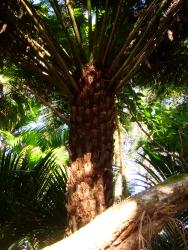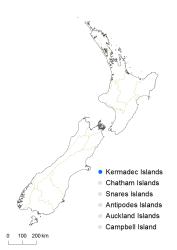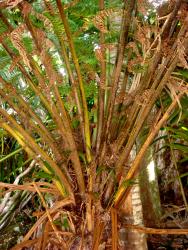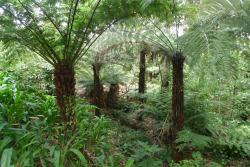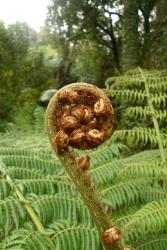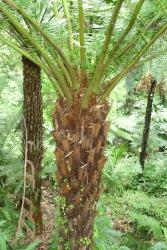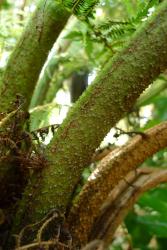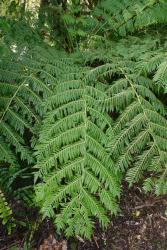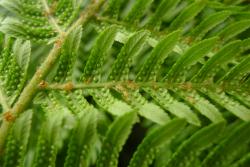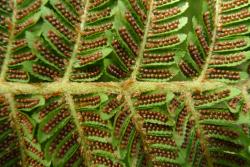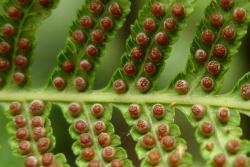- ≡ Alsophila milnei (Hook. ex Hook.f.) R.M.Tryon, Contr. Gray Herb. 200: 37 (1970)
Rhizomes erect, forming a woody trunk up to c. 8 m tall, 50–280 mm in diameter, covered in light brown projecting stipe bases; bearing scales near the apex. Rhizome scales marginate, acicular, lacking dark-coloured setae, chestnut-brown, shining. Fronds 1500–4000 mm long, held horizontally; dead fronds persistent. Stipes 70–400 mm long, 15–35 mm wide and 10–26 mm deep, green or pale brown throughout, strongly tuberculate and rough; scales at base of stipe chestnut-brown, up to 50 mm long and 3 mm wide, twisted, becoming more scattered distally. Laminae deeply 2-pinnate-pinnatifid to 2-pinnate-pinnatisect, elliptic or obovate, 1200–2800 mm long, 700–1200 mm wide, coriaceous; adaxial surface dark glossy green, abaxial surface dull green; adaxial surfaces of rachis and pinna midribs covered with colourless or pale brown curly hairs up to c. 1 mm long, but the lamina more or less glabrous; abaxial surfaces of primary pinna costae bearing abundant curly hairs, but those of the secondary pinna costae less hairy; abaxial surfaces of costae bearing abundant pale brown ovate scales, sometimes with a dark terminal seta, up to c. 4 mm long and 1 mm wide, the scales often occurring in irregular clusters along the costae; rachis pale brown or yellow-brown or green. Primary pinnae in 20–30 pairs, ovate or elliptic; the longest at or above the middle, 350–700 mm long, 150–260 mm wide, short-stalked. Secondary pinnae narrowly obovate, narrowly ovate or narrowly triangular, the longest 85–145 mm long, 15–33 mm wide, short-stalked or sessile, either deeply divided almost to the base, or completely divided into tertiary segments. Longest tertiary segments 8–15 mm long, 2.5–4 mm wide, adnate or decurrent; apices acute; margins shallowly to deeply serrate. Sori 0.7–1.0 mm in diameter; paraphyses shorter than sporangia; indusia covering sori before maturity, opening to form a deep cup with a smooth rim at maturity, usually quickly breaking apart.
Cyathea milnei is morphologically very similar to C. dealbata. The two taxa are characterised by abundant crisped or curled hairs on both surfaces of the laminae, and by indusia which open at maturity to form a deep cup that later breaks apart or spreads out to form a bowl shape. No other species in New Zealand have indusia of this type or such a preponderance of curled hairs. Cyathea milnei is distinguished by the green colour of the abaxial lamina surface compared to the distinctive white colour of most populations of C. dealbata, although there are several populations in northern New Zealand that have grey- or blue-green abaxial surfaces. Cyathea milnei also tends to have more persistent dead fronds on the trunks of mature plants, pale brown rather than white stipes and rachises, more conspicuously tuberculate stipe bases, proportionally fewer hairs and more scales on the abaxial costae, slightly larger sori (0.6–0.8 mm, cf. c. 0.5 mm wide), and more fragile indusia that break up easily. The status of the two species has been discussed by Brownsey & Perrie (2015). They are very closely related but are retained here as species in the absence of any definitive evidence to the contrary.
Kermadec Islands.
Altitudinal range: 25–500 m.
Endemic to Raoul Island.
Cyathea milnei grows more commonly in drier Metrosideros forest at low altitudes on Raoul Island, but a few plants extend into the higher and wetter forest. It is apparently more common than C. kermadecensis (Sykes 1977).
Cyathea milnei was given a conservation status of Naturally Uncommon by de Lange et al. (2013).
Cyathea milnei was described by Hooker (1864), but attributed to a manuscript description by William Hooker, based on specimens collected from the Kermadec Islands by John MacGillivray. In the Hookers’ Herbarium at K there are three sheets of material collected from the Kermadec Islands during the voyage of the Herald. Two were collected by W.G. Milne in 1855, and one by John MacGillivray in 1854. However, only the latter accords with Hooker’s protologue and is therefore the holotype.



